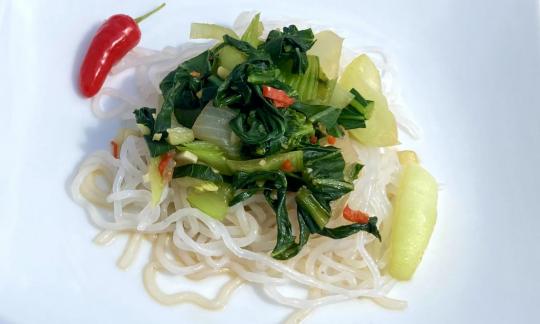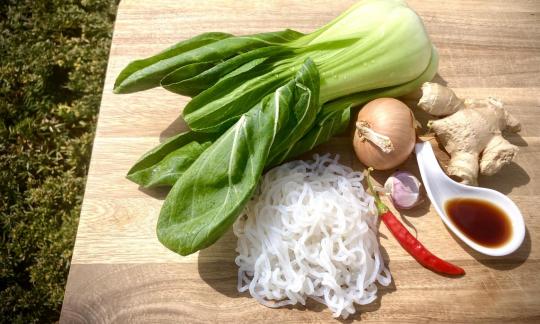Low-calorie Asian Shirataki noodles with pak choy
vegan
Ingredients (for servings, )
| For the Shitrataki noodles | |
|---|---|
| 8 ½ oz | Shirataki noodles (konjac, organic?) |
| 18 oz | Pak choy, raw (bok choy, organic?) |
| 1 | Onions, raw (organic?) (3.9 oz) |
| 2 cloves | Garlic (organic?) (0.21 oz) |
| 1 | Chili peppers, red, raw (organic?) (0.18 oz) |
| 1 tbsp | Ginger, raw (organic?) (0.30 oz) |
| 3 tbsp | Reduced salt soy sauce (Genen-Shoyu, organic?, raw?) (1.7 oz) |
Equipment
- skillet (frying pan)
- stove
- saucepan
- sieve
Type of preparation
- chop or grind
- sauté
- season to taste
- remove the skin
- peel
- drain
Preparation
For the Shirataki noodles
If you use dried pasta, put it in boiling, lightly salted water and cook for 5 minutes. Then put it in a sieve, rinse and drain. If you use pre-cooked pasta in liquid, first put it in a sieve and rinse well. The initial slightly fishy smell is normal, but will disappear. Then put it in boiling water for a minute and then drain.For the vegetables
Clean the pak choi and cut into strips. Cut the lighter, hard parts into pieces about the size of your thumb. Peel the onion and cut it into sixths (separating the individual layers from each other). Peel the garlic and chop it roughly. Finely chop the chili. Peel the ginger and chop it finely.In addition to pak choi, you can also add other vegetables that are suitable for Asian dishes, such as thin slices of carrot or mung bean sprouts.
Put the onions in a non-stick pan with a few tablespoons of water and sauté. After 2 minutes, add the pak choi, garlic, chili and ginger and sauté with more water if necessary. Always use only enough water so that the vegetables do not burn. After about another 5 minutes, add the soy sauce and season to taste. The vegetables should still be firm to the bite.
If you don't want to do without oil completely, you can use refined rapeseed oil here.
Completing the dish
Add the drained pasta, mix and season if necessary. Serve hot.
|
Nutritional Information per person
Convert per 100g
|
2000 kcal | |
|---|---|---|
| Energy | 98 kcal | 4.9% |
| Fat/Lipids | 0.61 g | 0.9% |
| Saturated Fats | 0.10 g | 0.5% |
| Carbohydrates (inc.dietary fiber) | 19 g | 7.1% |
| Sugars | 6.3 g | 7.0% |
| Fiber | 8.7 g | 35.0% |
| Protein/Albumin | 6.7 g | 13.4% |
| Cooking Salt (Na:926.9 mg) | 2'354 mg | 98.1% |
| Essential micronutrients with the highest proportions | per person | 2000 kcal | |
|---|---|---|---|
| Vit | Vitamin K | 158 µg | 210.0% |
| Vit | Vitamin C (ascorbic acid) | 121 mg | 152.0% |
| Sodium, Na | 927 mg | 116.0% | |
| Vit | Vitamin B9, B11 (Folate, as the active form of folic acid) | 177 µg | 88.0% |
| Vit | Vitamin A, as RAE | 559 µg | 70.0% |
| Vit | Vitamin B6 (pyridoxine) | 0.61 mg | 43.0% |
| Elem | Potassium, K | 748 mg | 37.0% |
| Elem | Calcium, Ca | 282 mg | 35.0% |
| Min | Manganese, Mn | 0.53 mg | 27.0% |
| Prot | Tryptophan (Trp, W) | 0.05 g | 19.0% |
Detailed Nutritional Information per Person for this Recipe
The majority of the nutritional information comes from the USDA (US Department of Agriculture). This means that the information for natural products is often incomplete or only given within broader categories, whereas in most cases products made from these have more complete information displayed.
If we take flaxseed, for example, the important essential amino acid ALA (omega-3) is only included in an overarching category whereas for flaxseed oil ALA is listed specifically. In time, we will be able to change this, but it will require a lot of work. An “i” appears behind ingredients that have been adjusted and an explanation appears when you hover over this symbol.
For Erb Muesli, the original calculations resulted in 48 % of the daily requirement of ALA — but with the correction, we see that the muesli actually covers >100 % of the necessary recommendation for the omega-3 fatty acid ALA. Our goal is to eventually be able to compare the nutritional value of our recipes with those that are used in conventional western lifestyles.
| Essential fatty acids | per person | 2000 kcal |
|---|---|---|
| Alpha-Linolenic acid; ALA; 18:3 omega-3 | 0.14 g | 7.0% |
| Linoleic acid; LA; 18:2 omega-6 | 0.13 g | 1.0% |
| Essential amino acids | per person | 2000 kcal |
|---|---|---|
| Tryptophan (Trp, W) | 0.05 g | 19.0% |
| Isoleucine (Ile, I) | 0.23 g | 19.0% |
| Threonine (Thr, T, irreversibly transaminated) | 0.14 g | 15.0% |
| Lysine (Lys, K, irreversibly transaminated) | 0.26 g | 14.0% |
| Valin (Val, V) | 0.19 g | 12.0% |
| Leucine (Leu, L) | 0.25 g | 10.0% |
| Phenylalanine (Phe, F) | 0.13 g | 9.0% |
| Methionine (Met, M) | 0.03 g | 3.0% |
| Vitamins | per person | 2000 kcal |
|---|---|---|
| Vitamin K | 158 µg | 210.0% |
| Vitamin C (ascorbic acid) | 121 mg | 152.0% |
| Vitamin B9, B11 (Folate, as the active form of folic acid) | 177 µg | 88.0% |
| Vitamin A, as RAE | 559 µg | 70.0% |
| Vitamin B6 (pyridoxine) | 0.61 mg | 43.0% |
| Vitamin B2 (Riboflavin) | 0.20 mg | 14.0% |
| Vitamin B1 (Thiamine) | 0.13 mg | 12.0% |
| Vitamin B3 (Niacin) | 1.4 mg | 9.0% |
| Vitamin B5 (Pantothenic acid) | 0.32 mg | 5.0% |
| Vitamin B7 (Biotin, ex vitamin H) | 2.2 µg | 4.0% |
| Vitamin E, as a-TEs | 0.27 mg | 2.0% |
| Essential macroelements (macronutrients) | per person | 2000 kcal |
|---|---|---|
| Sodium, Na | 927 mg | 116.0% |
| Potassium, K | 748 mg | 37.0% |
| Calcium, Ca | 282 mg | 35.0% |
| Phosphorus, P | 116 mg | 17.0% |
| Magnesium, Mg | 56 mg | 15.0% |
| Essential trace elements (micronutrients) | per person | 2000 kcal |
|---|---|---|
| Manganese, Mn | 0.53 mg | 27.0% |
| Iron, Fe | 2.2 mg | 16.0% |
| Copper, Cu | 0.10 mg | 10.0% |
| Zinc, Zn | 0.62 mg | 6.0% |
| Selenium, Se | 2.0 µg | 4.0% |
| Iod, I (Jod, J) | 1.3 µg | 1.0% |
| Fluorine, F | 2.1 µg | < 0.1% |
The low-calorie Asian Shirataki noodles with Pak Choy are quick and easy to prepare and ideal for losing weight.
Nutrient profile: According to GDA guidelines, one portion of this very low-calorie dish covers well over 100% of the average daily requirement of vitamins C and K. Folic acid and vitamin A are covered by a good 70%. The ratio of omega-6 to omega-3 fatty acids is 1:1, well below the maximum recommended ratio of 5:1.
You can find further information on this topic at the following link: Vegans often eat unhealthily. Avoidable nutritional errors.
Shirataki noodles: Shirataki noodles, also known as konjac noodles, are particularly popular in Japanese and Chinese cuisine. Shirataki noodles look similar to glass noodles, but are as thick as spaghetti. Unlike glass noodles, which are usually made from the starch of peas, corn or mung beans, Shirataki noodles are made from konjac roots, which is why they contain hardly any usable carbohydrates. They are therefore gluten-free, low in calories and filling. They have little taste of their own and their smell is slightly fishy. In addition to Shirataki noodles, which are available in the usual spaghetti form or as ribbon noodles, there is also so-called Shirataki rice (konjac rice).
Pak Choi: Pak Choi, also known as Pak choy or Pok Choi, is a Chinese cabbage. It has a mild taste and takes very little time to cook. Among other things, it contains a lot of glucosinolates, which are said to prevent cancer growth in small doses, but can be toxic to humans in large doses. However, eating typical portion sizes of raw Pak Choi like this is completely safe for healthy people.
Ginger: The ginger rhizome has an aromatic smell and a sharp, spicy taste, which is due to the substance gingerol, which is said to have anti-carcinogenic and anti-inflammatory effects. The substances borneol and cineol give ginger its digestive, stomach-strengthening, antiemetic, appetite-stimulating and circulation-stimulating properties. The ginger rhizome is used in cooking, in fresh, dried or ground form.
Salt and oil: We have deliberately left out oil for health reasons and reduced salt by using low-salt soy sauce. However, since salt requirements vary from individual to individual and depending on habits, you decide for yourself whether and how much salt you need. You can find more information on this topic in the book we have described: "Salt Sugar Fat" by Michael Moss.
In addition to pak choi, you can also add other vegetables that are suitable for Asian dishes, such as thin slices of carrot or mung bean sprouts.






